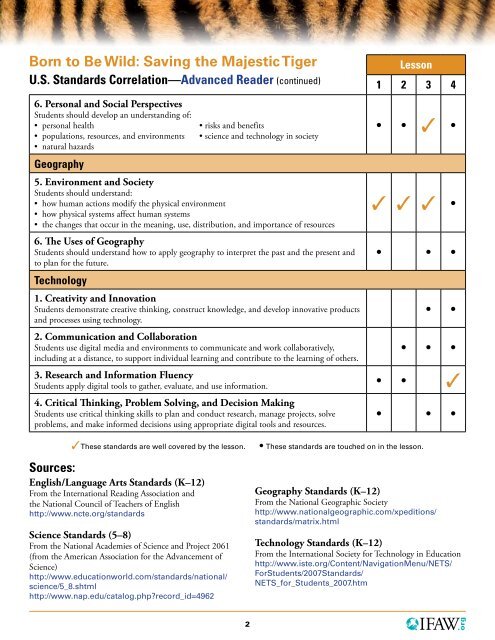Born to Be Wild - International Fund for Animal Welfare
Born to Be Wild - International Fund for Animal Welfare
Born to Be Wild - International Fund for Animal Welfare
You also want an ePaper? Increase the reach of your titles
YUMPU automatically turns print PDFs into web optimized ePapers that Google loves.
<strong>Born</strong> <strong>to</strong> <strong>Be</strong> <strong>Wild</strong>: Saving the Majestic Tiger<br />
U.S. Standards Correlation—Advanced Reader (continued)<br />
6. Personal and Social Perspectives<br />
Students should develop an understanding of:<br />
• personal health • risks and benefits<br />
• populations, resources, and environments • science and technology in society<br />
• natural hazards<br />
Geography<br />
5. Environment and Society<br />
Students should understand:<br />
• how human actions modify the physical environment<br />
• how physical systems affect human systems<br />
• the changes that occur in the meaning, use, distribution, and importance of resources<br />
6. The Uses of Geography<br />
Students should understand how <strong>to</strong> apply geography <strong>to</strong> interpret the past and the present and<br />
<strong>to</strong> plan <strong>for</strong> the future.<br />
Technology<br />
1. Creativity and Innovation<br />
Students demonstrate creative thinking, construct knowledge, and develop innovative products<br />
and processes using technology.<br />
2<br />
Lesson<br />
1 2 3 4<br />
• • ✓ •<br />
✓ ✓ ✓ •<br />
• • •<br />
• •<br />
2. Communication and Collaboration<br />
Students use digital media and environments <strong>to</strong> communicate and work collaboratively,<br />
including at a distance, <strong>to</strong> support individual learning and contribute <strong>to</strong> the learning of others.<br />
• • •<br />
3. Research and In<strong>for</strong>mation Fluency<br />
Students apply digital <strong>to</strong>ols <strong>to</strong> gather, evaluate, and use in<strong>for</strong>mation. • • ✓<br />
4. Critical Thinking, Problem Solving, and Decision Making<br />
Students use critical thinking skills <strong>to</strong> plan and conduct research, manage projects, solve<br />
problems, and make in<strong>for</strong>med decisions using appropriate digital <strong>to</strong>ols and resources.<br />
Sources:<br />
English/Language Arts Standards (K–12)<br />
From the <strong>International</strong> Reading Association and<br />
the National Council of Teachers of English<br />
http://www.ncte.org/standards<br />
Science Standards (5–8)<br />
From the National Academies of Science and Project 2061<br />
(from the American Association <strong>for</strong> the Advancement of<br />
Science)<br />
http://www.educationworld.com/standards/national/<br />
science/5_8.shtml<br />
http://www.nap.edu/catalog.php?record_id=4962<br />
• • •<br />
✓These standards are well covered by the lesson. • These standards are <strong>to</strong>uched on in the lesson.<br />
Geography Standards (K–12)<br />
From the National Geographic Society<br />
http://www.nationalgeographic.com/xpeditions/<br />
standards/matrix.html<br />
Technology Standards (K–12)<br />
From the <strong>International</strong> Society <strong>for</strong> Technology in Education<br />
http://www.iste.org/Content/NavigationMenu/NETS/<br />
ForStudents/2007Standards/<br />
NETS_<strong>for</strong>_Students_2007.htm

















